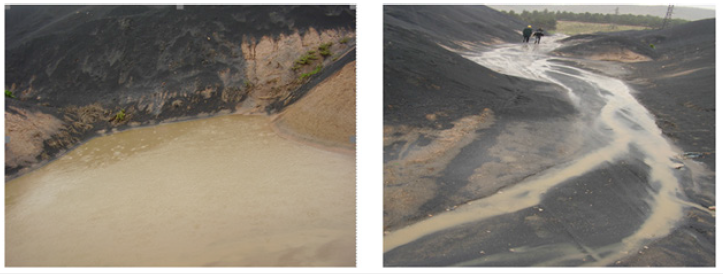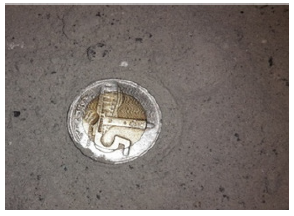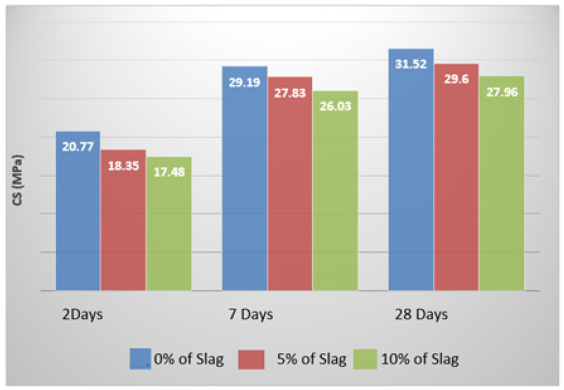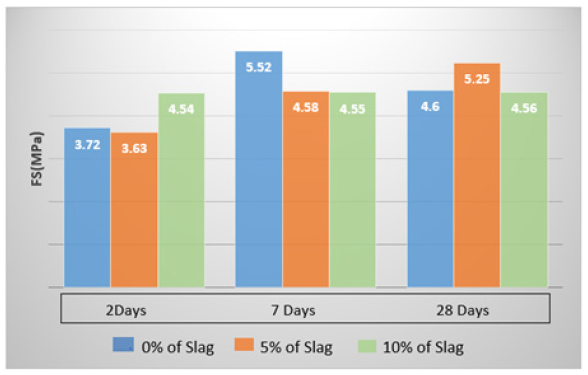- Submissions

Full Text
Aspects in Mining & Mineral Science
Management of Mining Wastes and Interest of their Recycling in Construction Materials: Case of White Slag from Steel Mills of EL Jadida in Morocco
Souad El Moudni El Alami1*, Omar Kinani1, Yassine Lasiani1, Mahamadou Koita1, Mohammed Er-rabhi2 and Wim Van den bergh3
1Laboratory of Applied Geosciences, Faculty of Sciences, Mohammed First University, BV Mohammed VI, P O Box 524, 60000 Oujda, Morocco
2SIGMACO Company, Oujda, Morocco
3University of Antwerp, Faculty of Applied Engineering, EMIB Research Group, Antwerp, Belgium
*Corresponding author: Souad El Moudni El Alami, Laboratory of Applied Geosciences, Faculty of Sciences, Mohammed First University, BV Mohammed VI, P O Box 524, 60000 Oujda, Morocco
Submission: August 15, 2022;Published: September 09, 2022

ISSN 2578-0255Volume9 Issue5
Abstract
Every year, billions of tons of waste are generated around the world. The production of these wastes has increased incredibly over time because of rapid urbanization, population growth and industrial development. The management of these huge quantities of waste is a great challenge to the producing countries. Morocco has a rich subsoil in various mineral resources distributed throughout the kingdom [1]. The main mining products are Phosphate, Coal, Lead, Iron, Zinc, Copper and Nickel [1]. There are officially 240 [2] mining sites in the country, among them 200 closed and abandoned sites. Today, several storage sites have been generated in the country. The wastes generated are mainly: coal ash, iron slag, lead slag and phosphogypsum [1,3-5]. The landfilling of these wastes directly threatens the environment [6] and causes additional costs for quarry management. In this work, we focus on the slag produced by the Sonasid steel plant in the Jorf Lasfar area of EL Jadida city In Morocco. This plant treats scrap metal to produce steel. The overall rate of slag produced by this company is 100,000t/year [4]. We distinguish between white slag and black slag. The black slag has been the subject of a previous study, which allowed its use in roads as a foundation and surface layer [3,4], while the white slag is still stored in the dumps. To minimise the risk of landfill, we carried out this experimental study to test the possibility of recycling white slag in mortars. Our results show that white slag can substitute cement with percentages of 5 and 10%.
Keywords:Mining waste; White slag; Environmental risk; Recovery; Mortar
Introduction
From an economic and environmental point of view, one of the major challenges today is the management of the big quantities of waste generated by industrial and urban activities. The amount of waste generated worldwide can be estimated at a few billion tons. About 58.4% [1] of the global industrial waste rate is generated by: China, Japan, India, South Korea and Australia [1]. These waste quantities are continuously increasing and will reach much higher amounts in the coming years. Among these waste generating activities, we mention the mining industry, which is criticized for the large quantities of mining waste produced during the exploitation of mineral deposits [2,7]. In fact, although the mining sector plays a major role in development, the management of waste is a major challenge. The amount of metal that can be recovered generally represents only a small fraction of the total mass: for example, the production of one ton of copper generates 200 tons of waste rock, and one ton of aluminum generates 400 tons of waste rock [2,7]. The global rate of mine waste is now estimated at about 30 to 60 billion tons per year [8], which is currently the largest waste stream on the planet. As a result, mountains of waste rock are stored in the open air and directly threaten the environment while modifying the natural landscape (Figures 1-3). The mining industry is therefore considered harmful to the environment and leads inevitably to the degradation of ecosystems. Abandoned mines that are not rehabilitated pollute and disturb the environment. In addition, the continued storage of waste is directly threatening human health and polluting natural resources such as waterways and soil as shown in the photos below [9,10].
Figure 1:Coal ash field in Jerrada Morocco [2].

Figure 2:Huge dust released during the exploitation of a mining site in ZAMBIA [9].

Figure 3: Contamination of the watercourses of Oued EL Himmer at the level of Touissit by the Zelija foundry slag [10].

Landfill is a direct source of risk to human health. Indeed, most of the industrial by-products (fly ash, white and black slag) are rich in heavy metals such as: zinc (Zn), nickel (Ni), cobalt (Co), chromium (Cr), arsenic (As), lead (Pb) and cadmium (Cd). These elements are harmful to human health and present a variable degree of toxicity, depending on their nature and their route of penetration (ingestion, breathing, contact with the skin). For example, the intoxication of As, affects the central nervous system and can induce coma and even death at 70 to 80mg. It can also affect: the digestive system, the nervous system and even the respiratory system. For the Cd, it acts mainly on the respiratory system, the kidneys and on the skin [4]. For the Cr, it is the second air pollutant after benzene, and it affects the respiratory system and the skin. At high concentrations of 10μg/ kg, it attacks the liver and becomes fatal. Cr is even responsible for lung cancer, especially in mine workers [4]. Ni is also harmful to human health and causes asthmatic problems. Pb is also counted among the dangerous elements, indeed, its accumulation can cause acute poisoning and various types of anemia. Its concentration in the blood is 100μg/l, it can increase to reach 250 to 350μg/l as is the case for traffic police officers and garage workers [4]. It also affects the nervous system and causes an increase in blood pressure, which leads to cardiovascular disease. This last paragraph shows the risk that landfill poses to human health and the environment, including surface and groundwater and agricultural land. This situation requires the search for a reliable and economic alternative solution.
Moreover, geotechnicians have realized the properties of some of these by-products, as is the case of coal ash, foundry and steel mill slag [1,3-7]. These properties can militate for their use in materials as total or partial substitute of aggregates or sands, hence the name of a by-product or co-product. The Moroccan guide of road earthworks provides the class F relating to the by-products and industrial waste next to the natural soil aggregates of types A, B, C and D [11]. The building materials is then an attractive field to consume important quantities of these by-products. This alternative is nowadays a promising environmental solution, which will allow the reduction of the exhaustive use of natural resources (aggregates, sand) and the reduction of storage costs. Several ways of valorization of these by-products have been evaluated. Among these ways, we mention concrete, mortar, roads [1,3,12-20]. This work focuses on the slag produced during steelmaking as a result of scrap processing. The estimated global rate of slag produced in the world is between 170 million and 250 million tons [21]. Morocco has 4 to 5 steel mills, of which we mention the Sonasid company which has two production units in EL Jadida and one in Nador. The Sonasid steel plant processes scrap metal to produce steel. The melting process takes place in an electric arc furnace at a temperature of 1500 °C. The raw steel is deposited at the bottom of the furnace and on the surface floats a mixture of impurities called slag. After cooling, the slag mixture is separated into white slag, which is fine, and black slag as aggregate. Because of the insufficient data, we don’t know the exact quantity of steelworks slag produced nationally but taking into account the 4 steel production units in the kingdom, we can estimate the amount of slag produced in the countries of 500,000 t/year.
In this work, we are interested in the slag produced by the steelworks of Sonasid in EL Jadida, which treats about 600,000t/ year of scrap metal to produce about 800,000 to 1 million tonnes of steel billets [4]. The rate of slag generated by the Jorf Lasfar plant in EL Jadida exceeds 100,000 tonnes, i.e. 17,000t/year of white slag and 90,000t/year of black slag [4]. The white slag is in powder form while black slag looks like aggregate. Black slag has already been studied, which has allowed its recycling in national roads [3,4]. However, the white slag has never been recycled. The objective of this research is to test the possibility of recycling white slag in construction materials in order to minimise the risks of landfilling. We then present the results of a study on the recycling of white slag produced by the Sonasid steel plant in Jorf Lasfar. that’s why, we used white slag as a partial substitute for cement in the mortar mix. Thereafter, à mechanical study was carried out on the mortars produced in order to ensure the technical feasibility of this recycling.
Materials and Methods
Used materials
The White Slags object of this study come from the Sonasid steel plant of Jorf Lasfar located in the industrial zone of Jorf Lasfar in EL Jadida. This steel plant uses the scrap to produce steel. The quantity of steel billets produced exceeds 800,000tons/year. This activity is accompanied by the production of by-products such as slag with an annual quantity exceeding 100,000 tons [11]. There are two types of slag: black slag, which is granular, and white slag, which is fine and is the subject of this experimental study. Black slag has already been studied [3,4], which has allowed its valorization in the road sector, however white slag has never been valorized. The objective then of our study, is to evaluate the possibility of recycling white slag in mortar. The sand used for making these mortars is a standardized sand of class 0/2mm. While the cement is class CPJ 55 and is produced at the Holcim Lafarj company in Oujda. This experimental study took place in the laboratory of SIGMACO company in Oujda in charge of the production of concrete for the manufacture of ready-mix concrete.
Characterization of the used materials
The characterization of the white slag and sand used was carried out according to Moroccan standards. The cleanliness is evaluated according to the sand equivalent test and the methylene blue test according to the standards NM 10.1.147 and NM 10.1.141. In addition, the chemical composition of the slag and the cement used was determined by the X-ray Fluorescence spectrometer (FX). The production procedure for mortars is described in the Moroccan standard NM 10.1.004 [22] for hydraulic binders. So, three series of mortars have been prepared. The first series is the standard mortar, containing 450g of cement, 1350g of standardized sand and 225g of water, which gives three mortar prisms. In the second and third series, part of the cement (CPJ35) mass is replaced by the white slag with percentages of respectively 5% and 10%. The prepared mixtures are introduced into the mortar molds, which will be stored in a wet cupboard at a temperature of 20 °C. After 24h, they are demolded, then stored in a water bath at a constant temperature of 20 °C. The samples will be crushed after 2, 7 and 28 days to evaluate their Compressive Strength (CS) and Flexural Strength (FS).
Results
Characterization
General appearance and grain size:The visual observation of the white slag shows that it is a fine powder of gray color very similar to cement, they can contain impurities of a few mm of dimension in the form of imbrulate (Figure 4). we have not performed the granulometric study because of the great fineness of the white slag and the absence of the laser diffraction technique. However, other similar studies have shown that white slag has a maximum size of 140μm [21].
Figure 4: Visual aspect of Sonasid’s white slag.

Cleanliness:The sand equivalent test carried out on the white slag gives 33%, which shows that it is a material of low cleanliness compared to natural sand. In addition, the Methylene blue test gives 0.25. These two results allow to classify the white slag between sandy-loam and sandy-clay soils according to the Moroccan catalog of road earthworks (GMTR). On the other hand, and for the sand used, the sand equivalent value is very high.
The apparent density:The apparent density of the white slag measured in a cylindrical container of 10 liters gives as result 1.183g/cm3. This value is very close to that of the cement (0,9-1,2g/ cm3).
Chemicals composition:The elemental composition of the of the white slag is given in Table 1. The results show that the white slag mainly consists of: CaO, SiO2 and CaF2. with small amounts of: Al2O3, MgO, and FeO. The comparison of these results with the chemical composition of black slag [4], shows that the latter is rather rich in CaO and Fe2O3 with, also, a low content of Al2O3, MgO. For the used cement, we also present its chemical composition on the Table 2.
Table 1:Elemental composition [%] of white slag and comparison with black slag.

Table 2:Elemental composition [%] of used ciment (CPJ35).

Study of the feasibility of using white slag in mortar
Variation of the mechanical properties of mortars according to the dosage of white slag:We remind that in this study, we used white slag in the mortar as a partial substitute of cement (CPJ35). Three series of mortars were confectioned: the first is the standard formulation. The second and the third contain respectively 5% and 10% of slag of the total mass of cement (450g). After curing, the mortar prisms studied were crushed, at different ages, by flexion and compression. The results obtained are summarized in Table 3 and Figures 5 & 6 below.
Table 3:Mixture composition and compressive and flexural strength of the mortars studied.

Interpretation of results
The results presented in Table 3 and Figures 5 & 6 below show that the Compressive Strength (CS) for the three mixes studied increases with age. Thus, for the standard mortar, the CS at 2 days is 20.77Mpa which represents a very satisfactory result with respect to the strength class of used cement [21]. At 28 days age, the CS of the standard mortar approaches 32MPa and is conforms to the standard (between 25 and 45MPa) [22]. For 5% of white slag, we noticed, at all ages, a small decrease in the CS (-2MPA), but the strength at 28 days approaches 30MPa and remains conform to the standard (>25MPa) [22]. For the third series of mortars, we used 10% of white slag, the results of CS show a decrease of 3MPa compared to the reference mortar, but this decrease is small and the CS at 28 days is still tolerable and exceeds the limit (>25MPa) [22]. For the variation of Flexural Strength (FS), we note that the values recorded for the two series based on slag (5% and 10% slag) change slightly compared to that of the standard mortar but remains within the norms [22]. These strengths can become more important if we have ground as has been shown in other similar studies [4] because the fineness of the particles increases the specific surface and decreases the porosity which increases the compressive strength. However, we noticed that the FS for the standard mortar increased at 7 days to reach its maximum value (5.52Mpa) then decreases at 28 days to a value of 4.6MPa which remains an unexplainable result.
Figure 5: Variation of the Compressive Strength (CS) of the three series of mortars studied.

Figure 6: variation of the Flexural Strength (FS) of the three series of mortars studied.

Conclusion
This study is carried out on one of the by-products of the steel
industry in Morocco. It is in particular the white slag produced
by the Sonasid steel plant in the EL Jadida city. The objective of
this research work is to test the possibility of recycling this slag
into construction materials, especially as a partial substitute for
cement. Therefore, and after a complete characterization study of
the white slag, three series of mortars have been made: the first is
the standard formulation based on cement, water and normalized
sand. The second and the third contain respectively 5% and 10% of
slag as substitute of the cement mass. The mechanical properties of
mortars based on slag, were compared with those of the standard
mortar. The results obtained then allow to make the following
conclusions:
a. Sonasid’s white slag are visually similar to cement
b. The cleanliness of the white slag is low, which is expressed by
coefficients of sand equivalent ES=33% and methylene blue
VBS=0.25. This allows to classify them between sandy-loamy
and sandy-clay soils according to the Moroccan catalog of road
earthworks (GMTR) [11].
c. The apparent density of white slag is 1.183g/cm3. This value is
very similar to that of cement (0.9-1.2g/cm3)
d. X-ray fluorescence analysis shows that the chemical
composition of white slag is marked by the dominance of:
CaO, SiO2 and CaF2 with a low content of: Al2O3, MgO and FeO.
This encouraged us to study the possibility of their use in
construction materials, especially as a substitute for cement.
e. The study of the properties of mortars based on white slag
shows that the two percentages studied (5 and 10% slag)
give very satisfactory Compressive Strength (CS) and Flexural
Strength (FS) [22], although the small decrease compared to
the reference sample (0% slag).
The results of this research are an initial step in the recycling of white slag in the field of construction materials, particularly cement. However, the challenge remains very important if we consider the millions of tons of these by-products stored in large quantities. Further research should complete this initial study by carrying out other tests, in particular the study of the shrinkage and swelling of mortars containing this slag. Moreover, an environmental study by the leaching test is necessary to ensure the non-toxicity of this recycling.
Acknowledgement
We would like to thank the company Sonasid of EL Jadida for giving us the samples of white slag to make this study and also for having realized the chemical analysis to these by-products. As we thank the company SIGMACO of Oujda for their collaboration in allowing to make this experimental study in its laboratory.
References
- EL Moussaoui R (2021) Recovery of mining waste from the oriental region in civil engineering: Case of slag from Zellidja, Province of Jerada. Application in Road Engineering, Oujda. State Doctorate Thesis, Faculty of Sciences, Mohamed Premier University, Oujda, Morocco.
- Boushaba A (2021) Course 2 treatment of mining waste. University sidi Mohamed ben Abdelahh, Morocco, pp. 7-20.
- El Moudni EAS, Moussaoui R, Monkade M, Lahlou K, Hasheminejad N, et al. (2019) Lime treatment of coal bottom ash for use in road pavements: Application to El Jadida zone in Morocco. Materials 12(17): 2674.
- El Moudni EAS (2010) Contribution to the study of valorization of coal ash and steelworks slag in Civil Engineering. State Doctorate Thesis, Faculty of Sciences, Chouaib Doukkali University, El Jadida, Morocco.
- Lahlou K (2003) The search for a viable process for the valorization of a Moroccan phosphogypsum. French-speaking Review of Industrial Ecology REVUE N°
- Cabrera M, Galvin AP, Agrela F, Beltran MG, Ayuso J (2016) Reduction of leaching impacts by applying biomass bottom ash and recycled mixed aggregates in structural layers of roads. Materials 9(4): 228.
- Koita M (2022) Interest in the recovery of Mining Waste in the field of Building Materials. Faculty of Sciences, Mohamed Premier University, Oujda, Morocco, p. 33.
- Pascal PA (2022) Solution to the World's largest waste stream: Making sand, press release. University of Geneva, Switzerland.
- La tribune Afrique Zambia wants to deal with the damage of mining.
- Ghazi M (2006) Study of depollution of the discharges of the foundry of the wadi El Himer. Mission I: Diagnosis and solution. Design Office Sanitation Environment Urbanism Agricultural Development p. 79.
- DRCR (2001) Moroccan guide for road earthworks “GMTR“, booklet I: general principles. Directorate of Roads and Road Traffic of Morocco, Morocco.
- Hashemi SSG, Mahmud HB, Djobo JNY, Tan CG, Ang BC, et al. (2018) Microstructural characterization and mechanical properties of bottom ash mortar. J Clean Prod 170: 797-804.
- Bendapudi SCK, Saha P (2011) Contribution of fly ash to the properties of mortar and concrete. International Journal of Earth Sciences and Engineering 4(6): 1017-1023.
- Tambara Júnior LUD, Cheriaf M, Rocha JC (2018) Development of alkaline-activated self-leveling hybrid mortar ash-based composites. Materials 11(10): 1829.
- Singh N, Mithulraj M, Arya S (2018) Influence of coal bottom ash as fine aggregates replacement on various properties of concretes: A review. Resour Conserv Recycl 138: 257-271.
- Van den Heede P, Ringoot N, Beirnaert A, Van Brecht A, Van de Brande E, et al. (2016) Sustainable high quality recycling of aggregates from waste-to-energy, treated in a wet bottom ash processing installation, for use in concrete products. Materials 9(1): 9.
- Singh M, Siddique R (2013) Effect of coal bottom ash as partial replacement of sand on properties of concrete. Journal of Cleaner Production 112: 620-630.
- Hasnain Saeed M, Shah SAR, Arshad H, Waqar A, Imam MAH, et al. (2019) Sustainable silicon waste material utilization for road construction: an application of modified binder for marshall stability analysis. Appl Sci 9(9): 1803.
- Lin Y, Hu C, Adhikari S, Wu C, Yu M (2019) Evaluation of waste express bag as a novel bitumen modifier. Appl Sci 9(6): 1242.
- Churchill EV, Amirkhanian SN (1999) Coal ash utilization in asphalt concrete mixtures. J Mater Civ Eng 11(4): 295-301.
- Jiayun Z, Hiroyuki M, Fumitaka T (2014) Treatise on process metallurgy. Industrial Processes 3: 1507-1561.
- (2018) Moroccan standard NM 10.1. 004 on hydraulic binders - cement composition, specifications and conformity criteria.
© 2022 Souad El Moudni El Alami. This is an open access article distributed under the terms of the Creative Commons Attribution License , which permits unrestricted use, distribution, and build upon your work non-commercially.
 a Creative Commons Attribution 4.0 International License. Based on a work at www.crimsonpublishers.com.
Best viewed in
a Creative Commons Attribution 4.0 International License. Based on a work at www.crimsonpublishers.com.
Best viewed in 







.jpg)






























 Editorial Board Registrations
Editorial Board Registrations Submit your Article
Submit your Article Refer a Friend
Refer a Friend Advertise With Us
Advertise With Us
.jpg)






.jpg)














.bmp)
.jpg)
.png)
.jpg)










.jpg)






.png)

.png)



.png)






